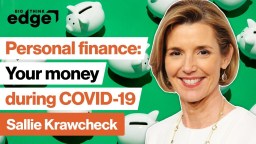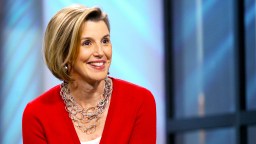Women have different financial strategies and insight than men, argues Sallie Krawcheck, the co-founder and CEO of Ellevest, a digital investment platform for women. Female investors have a different sense of why they want to make money, pursue specific goals more readily, and show a unique sense of risk awareness. Krawcheck says it’s important for women to play the market and plan financially because there is a real retirement savings crisis in this country which disproportionately affects them.
So if you think about investing today it tends to be all about outperforming the market. It tends to be about making more money and it tends to be about picking and choosing the right stock, the right mutual fund. Mutual fund versus an ETF. The right money manager.
And that has worked eh, I was going to say well for the population, but frankly it has worked okay for the population. Why? Because the goal that the industry set itself a long time ago of active management and outperforming the market…well less than one percent, well less than half a percent of money managers outperform the market consistently over any five year period.
Okay, so back up. When we did our research with women the concept of “beating the market” fell completely flat. The concept of “winning” fell flat. In fact, even the concept of “making more money” fell pretty flat—sort of surprising to me, it seemed like a pretty good goal.
What worked for women were actual goals. So okay, if I’m going to put my money aside and invest my money, I want to be able to in X number of years buy my dream home, have a child, start a business, retire well, take that trip around the world that I wanted to. And so we found that women tend to be more goals-oriented and focused than men.
Another finding for us: Men tend to, if you ask them the question about their risk tolerance—which, by the way, the whole industry does—men will answer. By the way, they don’t know what it is. We only ever learn what our risk tolerance is really when we go through downturns.
But women we found were, “Oh, oh my gosh. You know what, I’m going to think about that. Let me think about that and I’ll get back to you.” And they never do. It really shuts down the conversation.
And so we instead of asking a question we know people don’t have the wherewithal to answer, instead we say “Okay, let us learn about you through taking you through the product and the capability. Tell us what your goals are and then we’ll tell you essentially how much risk you can afford.” So for an example you and I are the same person. We make the same salary. We have the same level of education. We’re the same age. And you don’t have an emergency fund so you don’t have cash set aside for a rainy, rainy day and you want to have a baby in four years.
I just need to retire, right. It doesn’t really matter what I think my risk tolerance is. You don’t get a lot of risk. I get plenty of risk.
And so we tweaked things like that as well as really – so making it goals based, approaching risk differently, taking into account again that women live longer and salaries peak sooner, forecasting out their life curves.
And then the most important change we found is that most people think of and describe women as risk-averse investors. What we found, maybe a subtle point, is women are risk-aware investors.
And what they wanted was not hey, explain risk to be in standard deviation and “Let’s really go through that statistical analysis,” but more, “Hold on, how bad can it get?”
And so what we would do is we track you, track women to their goal and say in X percent of markets it could be this bad and in Y percent that bad. And if you fall off track, if you fall off track to reach your goal we’ll reach out to you, tell you you’re off track and tell you what you have to do to get back on. Deposit another thousand dollars, retire six months later. So those are a few of the differences, some of which are straightforward (and others of which are more subtle) that we found were barriers to keeping women from investing.
So I’m the co-founder and CEO of Ellevest, which is an digital investment platform for women. If you had told me a couple of years ago that I should build a digital investment platform for women I would have told you you were sexist. I would have told you it was a really stupid idea. And I would have probably been somewhat disdainful to you about it. And what I would have said was, “You know, women don’t need anything different from men. What do you think, our lady brains can’t handle the big man-brain numbers?”
But then one morning I had an insight, which is the retirement savings crisis in this country is really a women’s issue and a women’s crisis. We retire with two-thirds the money of men and we live six to eight years longer. Eighty percent of nursing home residents are women.
So it really is, while we’re not used to thinking about it through a gendered perspective, it is really a women’s issue. That changes the solutions. They go from being all about tax increases and entitlement cuts to being about women having more money.
So how do we get women more money? Well there are a lot of people working on the gender pay gap and they gender work achievement gap, but it struck me at about the same time that there’s a gender investing gap.
That it costs women hundreds of thousands of dollars, some women millions of dollars over the course of their lives, because they don’t invest as much as men do. We women tend to blame ourselves. “Oh, I need more financial education. I really need to dig in and do this. I just have to find the right company.”
But it struck me as I sort of dug into it that maybe the problem is not ours as women. Maybe the challenge is that it’s an industry that’s by men, for men. That 86 percent of financial advisors are men, and that number has head steady for forever. And as a result it just fits men better.
And the words they use: Beat the market, outperform, pick a winner are words of war and sports. The investing TV is like watching sports Sunday, and the industry symbol is a bull, so it’s a phallic symbol. So in every way it’s sort of set for men.
Include the fact that men will invest through jargon and women won’t.
And you have an industry that doesn’t feel right for women. So we decided to dig in and change not just the marketing. Lots of people market to women, but the underlying product as well to take into account what we were learning about women and how they invest. And to take into account the fact that we live longer. That’s important when you’re forecasting how much income you need for retirement. Our salaries peak sooner. That’s completely unfair, but is important when putting together financial and investing plans.





